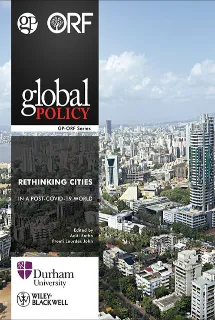Editors’ Note
Cities around the world have faced the brunt of the COVID19 pandemic due to widespread international connectivity, the movement of people and goods, and commercial and recreational activities in constricted spaces. Denser cities have proved to be easy targets, perhaps due to the assumption that they are anathema for social distancing. However, density by itself need not be the only vulnerability. While cities like Mumbai, New York and London have reported staggering rates of infection, other dense cities like Singapore, Seoul and Hong Kong have managed to keep the worst of the virus at bay. According to a World Bank study of 284 cities in China, cities with extremely high population densities—such as Shanghai, Beijing, Shenzhen, Tianjin, and Zhuhai—have had far fewer confirmed cases per 10,000 people (1). Research on economic geography also shows that density helps economies grow—the higher the density, the shorter the distance between workers, businesses, and parts of supply chains (2).
What has caused so many major cities to crumble under the onslaught of the virus? Inadequate social and physical infrastructure—coupled with density—has proved to be the undoing of many big urban spaces. The lack of coordination and data amongst relevant authorities and other key individuals are also factors that have exposed certain cities to the outbreak more than others.
The longer the pandemic rages on, the more important becomes the question of how we live and grow in urban conglomerations. What are the fissures that COVID-19 has exposed in city-planning today? How can urban planning systems equip themselves better for future pandemic management? Rethinking Cities explores the relationship between the pandemic and urban health infrastructure, climate resilience, informal settlements and work, social infrastructure, and commercial investments, to provide a potential direction for urban planning to mitigate the risks from future health crises.
Healthy cities
The modern development of cities has taken root around a central binding theme, be it green cities, smart cities, or sustainable cities. The pandemic has revealed that making healthy cities a parameter for development is also essential. Strengthening urban healthcare infrastructure to handle the rush of patients with new infections, and disruptions in general healthcare services, particularly public health services like immunisation, will prevent urban populations from being exposed to additional infections and disease outbreaks. Existing urban primary health structures need to be strengthened physically and financially, along with effective and advanced monitoring, surveillance and accountability. City-level administration must also be seamless, and all tiers of healthcare must work together with a unique and standard pandemic related operating procedure.
Strengthening health infrastructure must also go hand in hand with using digital tools to amplify healthcare delivery. The COVID-19 crisis has seen a surge in the use of telemedicine services, which citizens were heretofore slow to embrace. The sudden increase in the use of digital health accessories will create the required testing ground for the advancement of health-tech that enables traditional forms of health services rather than replaces them. This shift in healthcare delivery shall also propel the arrival of digital-savvy health workers with technology-oriented education and skilling programmes being introduced in medical, nursing and paramedical curricula.
Green cities
Some of the fractures introduced during the COVID-19 crisis are with regards to the lack of open spaces, ineffective resource management for the affected population, and disruptions in energy consumption. These are matters that have a base in the absence of appropriate urban planning for resilience and sustainability. A synchronised strategy that responds to both COVID-19 and the climate crisis must be implemented so that we do not see adverse effects of both during potential pandemics. Focusing on circular economy frameworks, sustainable urban mobility, and accelerating investment in green infrastructure and renewable should be priorities.
The transformation in the transportation sector will also need to align with the green agenda to make cities resilient and sustainable to future pandemics. Changes in transit preferences and user behaviour due to paranoia about congestion will need to be balanced with institutional decisions on how to mitigate such bottlenecks. Creating well-ventilated public transport with congestion caps and pricing, and encouraging the use of non-motorised transport are some of the ways how this balance can be achieved.
After months of lockdowns and quarantine, with populations experiencing ‘COVID-19 fatigue’ and a breakdown in adhering to precautions, open spaces for recreation and physical activity have become crucial. Cities that lack such areas must re-evaluate space management to mitigate the mental and physical health impacts of pandemics in the future. These evaluations can be done in tandem with improving the city’s climate-resilient facets. Land-scarce cities make it difficult to create new spaces; therefore, climate-harming spaces can be repurposed for environmentally-friendly gatherings for healing that do not compromise social distancing requirements but alleviate the anxiety of social isolation.
Inclusive cities
Conversations surrounding the need for cities to accommodate the considerations of its vulnerable populations began much before the pandemic. This crisis has added a new dimension to the anguish of the vulnerable, and initiated a dialogue on what can be done to prevent such suffering in the future.
Pandemic responses must be bolstered by an urban-planning system that includes sex-disaggregated data collection on the number of people, number of households, pockets and areas of vulnerability, as well as the availability of sanitation and hygiene amenities. Preparedness and response plans cannot be made unless the number of people living in vulnerable areas and information on the civic amenities available to them is known. A focused drive to collate up-to-date data of formal-informal settlements and labourers in cities is essential to correctly gauge the funds that will be required to provide adequate access to food supplies, housing, sanitation, and financial services.
A gendered analysis of the effect of the pandemic on job losses and employment trends is also crucial to work on rehabilitation post-pandemic. Urban planning must include better data management to mitigate the deadliest impacts of future pandemics. This information, together with the effective coordination that city systems can provide, will be crucial in the deployment of essential services to the vulnerable.
Rising cities
The post-pandemic world will see significant changes in the social, physical and financial infrastructure of cities. With safety being the primary consideration, building design and office layouts shall transform as per health protocols adopted during the crisis.
Cities will continue to create skyscrapers and slums simultaneously while keeping their urbanisation goals intact. However, an urban growth plan that synchronises formal employment generation with the formulation of effective housing schemes will prove to be the most effective.
As the post-pandemic world shrinks and the rapid progression of globalisation wanes, there may be a reconceptualisation of cities as singular nodes of trade, commerce and knowledge. The mobility of commodities and labour will be primarily restricted within demarcated governance zones, and cities may rise as self-sufficient units.
The COVID-19 crisis will result in substantial adjustments in how we shape, administer and live in cities. Our understanding of cities, as dense conglomerations of constant social interactions, might be overhauled. We must come to terms with this and ensure that systems undergo the changes that accompany this understanding, be it in mobility, housing, employment, or financial investments. While it may seem impossible to do in the immediate future, stakeholders must make concerted efforts in making the changes that will assist crisis prevention in the future, and also mitigate the adverse short-term consequences of the pandemic.
Endnotes
CONTENTS
Healthy Cities
- Healthcare Delivery Must Embrace the Digital Space: Sheetal Ranganathan
- India’s Urban Healthcare System Must Adapt to the New Normal: Oommen C Kurian
Green Cities
- Reimagining Urban Spaces for Community Connections and Climate Resiliency: Elizabeth Hessek and Ashali Bhandari
- Building Blocks of a Post-COVID-19 Green City: Tanushree Chandra
- Transportation Must Transform in the Post-Pandemic Era: Amruta Ponkshe
Inclusive Cities
- Women and the City: Embracing Gender-Sensitive Policies: Saloni Atal
- Protecting the Future of Urban Workers in a Post-Pandemic Automated World: Aditi Ratho
- Providing Urban Poor with Livelihoods is Crucial Post COVID-19 67: Ramanath Jha
Rising Cities
- Reimagining the Workspaces of the Future: Sangeet Jain
- The Rise of Cities: Economic Drivers in the Post-Pandemic World: Soumya Bhowmick
- From Slums to Skyscrapers: Redesigning Urban Habitat Policies: Renita D’Souza
- Inclusivity in Knowledge Cities in the Post-COVID-19 World: Manvita Baradi and Kaninik Baradi
The views expressed above belong to the author(s). ORF research and analyses now available on Telegram! Click here to access our curated content — blogs, longforms and interviews.

 PDF Download
PDF Download



 PREV
PREV



